Long Question Answers: Geological Structure and Physiography | Geography Class 11 - Humanities/Arts PDF Download
Q. 1. “The present day geomorphological divisions of the sub-continent have evolved in the course of a long geological history.” Elaborate the above statement.
Ans. Indian sub-continent is divided into three physiographic regions at macro level. These have been evolved in the course of a long geological history. The past is still a mystery. The present day topography is the result of interaction of different courses over a long period.
1. The Plateau : The peninsular plateau is an old crystal block lifted in the pre-cambrian (1600 million years ago). It has been compared to a horst lifted above sea level. It has been a part of the super continent Gondwana land. Many structural changes occurred in the evolution of the plateau such as :
(i) Aravallies mountains were uplifted in Palaeo-zoic times.
(ii) Nallamalai range of the south was folded during the same period i.e. Vindhyan period.
(iii) Faulting along with vertical movements occurred in the river valleys of Godavari, Mahanadi, Narmada and Tapti.
(iv) Along with faulting, subsidence took place along the Malabar Coast.
(v) After that, extensive lava flow resulted in the formation of Deccan plateau.
(vi) Arabian Sea was formed due to subsidence along the west coast.
(vii) Similarly western ghats were formed as a result of the tilting of the peninsular plateau.
2. The Himalayas : The Himalayas are young fold mountain system. This region was occupied by the tethys geogyncline as late as mesozoic times (270 million years back). The sediments deposited in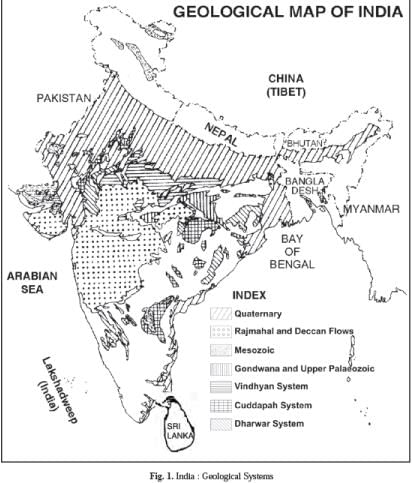
the tethys sea were folded to form the Himalayas during the tertiary period. The Himalayas and its mountain ranges were gradually uplifted spreading over millions of years.
The Himalayas were uplifted in three stages :– Central Himalayas, Potwar region and the Siwalik ranges. The mountain building movements occurred in different stages. The first uplift was marked during oligocene period. The second phase took place during the Miocene period. The third phase took place in the post-Pliocene period. It has been observed that the Himalayas are still rising. Most of the present relief is the result of weathering and erosion by different agents. The
Himalaya phases of mountain building may be explained in the light of the theory of Plate tectonics. The Himalaya ranges were formed when the Indian plate was driven northwards and pushed beneath the Eurasian plate.
3. The plains : The great plains of India lie in between the Himalayas and the plateau. It has been formed by filling of a marine depression by sediments brought down by the Himalayan rivers. The depression is derived to exist as a ‘foredeep’ formed by the subsidence of the northern flank of the plateau. The depression has been filled gradually. Rajmahal and Garo hills have been regarded as the boundaries of this depression and this gap has been filled by the Ganges alluvium in Bengal.
Q. 2. Divide India into major physiographic divisions. Describe each in detail.
Ans. MAJOR PHYSIOGRAPHIC DIVISIONS India is a vast country where severe contrasts are found in relief. It has a unique relief marked by a variety of features which stand out boldly in contrast to others.
The total geographical area is divided into different parts as :
Mountains 10.7% Hills 18.6% Plateaus 27.7% Plains 43.0% India is divided into four major physiographic divisions. The Peninsular India is the core of the geology of India. It is the oldest part of India. In the Northern part, the Himalayas adorn like a crown of India. The Gangetic plain is the cradle of Indian Civilisation. The four independent and definite physiographic regions are :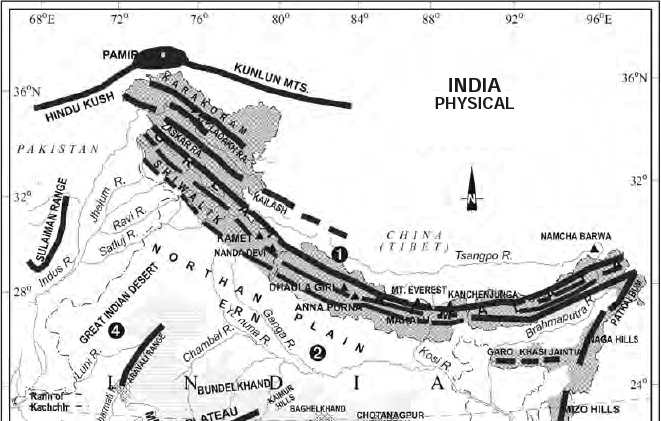
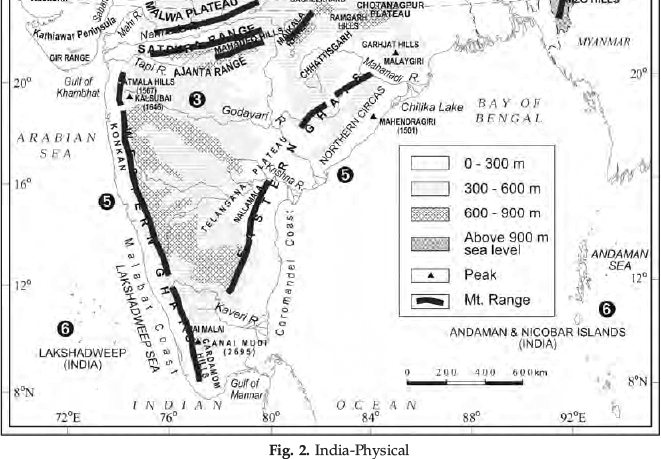
1. The Northern Mountain Region
2. The Sutlej-Ganga Plain
3. The Peninsular Plateau
4. The coastal plain and islands.
1. THE NORTHERN MOUNTAIN REGION
Extent : The Himalayas run in an east-west direction in the northern part of India. This mountain range is 2400 km. long and 240 to 320 km. wide. These are the youngest and the highest fold mountains of the world.
Main Characteristics
(i) These are young fold mountains as these have been formed in recent times.
(ii) These have been formed in tertiary period (5 crore years ago).
(iii) These were formed at the site of Tethys Sea.
The sediments were uplifted to form high mountains. The Himalayas are still rising in some parts.
(iv) The Himalayas are a series of parallel ranges intersected by deep valleys and broad plateaus.
(v) These ranges are compared to a sword or a bow.
(vi) The average height of the Himalayas is 5000 metres.
(vii) Youthful rivers form narrow, deep valleys and gorges across the Himalayas.
(viii) The Himalayas show evidences of glaciation such as Karewas in Kashmir valley.
Regional Division. The Himalayas, from Indus valley to Arunachal Pradesh, can be divided into four divisions :
(i) Assam Himalayas–Between the Tista and Brahmaputra rivers. (720 km. long)
(ii) Nepal Himalayas–Between Kali and Tista rivers. (800 km. long)
(iii) Kumaon Himalayas–Between Sutlej and Kali rivers. (320 km. long)
(iv) Kashmir Himalayas–Between Indus and Sutlej rivers. (520 km. long) From the point of height,136 the Himalayas can be divided into four ranges which run parallel to each other.
(i) Trans Himalayas
(ii) Great Himalayas or (inner Himalayas)
(iii) Lesser Himalayas or (middle Himalayas)
(iv) Sub-Himalayas (Shiwaliks) or (outer Himalayas).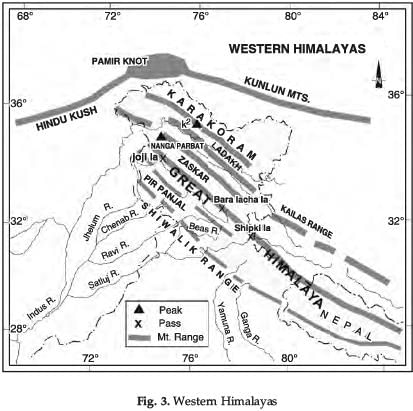
1. Trans Himalayas. Trans Himalayas include Karakoram, Ladakh and Kailash ranges which overlook the great Himalayas. K2, Mt. Godwin Austin (8611 metres) is the world’s second highest peak. It is a region of lofty peaks and glaciers. Siachen glacier is one of the longest glaciers of the world.
2. Great Himalayas. It is the largest mountain range between Indus and Brahmputra rivers. It has an average height of 6000 metres. These are snow covered mountains and are called ‘Himadari’ mountains. Two valleys have been formed by filling up of lakes–as Kashmir valley and Kathmandu valley.
3. Lesser Himalayas. These ranges have an average height between 3000 to 4500 metres. This range lies parallel to great Himalayas in the southern part. It is often called 'Himachal' or Middle Himalayas.
Pir Panjal, Dhauladhar, Kumaon, Thimpu ranges are found in different parts of it. Many tourist resorts are situated on lesser Himalayas. 4. Shiwaliks. These are also called outer Himalayas. These are the foot-hills of the Himalayas.
Its average height is 1000 metres. Its width varies between 15 to 50 kms. In between the Shiwaliks and lesser Himalayas. Doons (longitudinal valleys) are found such as Dehradun, Kothridoon and Patlidoon.
Eastern Offshoots. Patkoi, Lushai, Naga hills, Garo-Khasi, Jaintia hills form the eastern offshoots of the Himalayas.
Western Offshoots. Salt range, Kirthar, Sulaiman ranges are the western offshoots of Himalayas.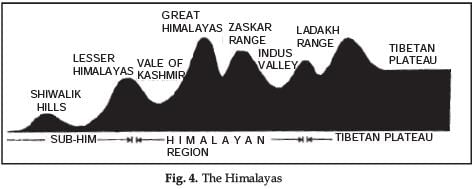
2. THE SUTLEJ GANGA PLAIN
Extent : The great plain extends in between the Himalayas and the Peninsular plateau. It is 3200 km. long and 150 to 300 km. wide. Its minimum width is 90-100 kms. in Assam. Its width is 160 kms. near Rajmahal hills and 280 kms. near Allahabad. Its average height is 150 metres. It covers an area of 7.5 lakh sq. km.
Formation : It is an alluvium filled trough. It has been formed by the deposition of sediments brought from the Himalayas by the Ganga, Sutlej and other rivers. It was a fore-deep along the Himalayas and has been filled by deposition of sediments. The Ganga river deposits a load of 3000 lakh tones in this plain.
Main Characteristics
(i) It is a dead flat lowland. The maximum height is 263 metres near Ambala. The uniformity of the plain is a remarkable feature. At places, regional variations occur in the form of river terraces, Bluffs and Bhangar.
(ii) It has a gentle gradient ( 1/4 metre per km.)
(iii) It has huge depth of alluvium 2000 metres.
(iv) A large number of rivers flow in this plain dividing it into Doabs.
(v) It has fertile alluvial soils namely Khadar and Bhangar soils.
Division of Northern plain
(i) Bhabar and Terai. It is a long, narrow zone along the foot-hills from Indus to Tista rivers. It is a pebble-studded zone. Swampy areas occur in Terai.
(ii) Punjab Plains. This plain has a slope in the South West direction. It has been formed by the deposition of sediments by Ravi, Beas and Sutlej rivers.
Chos (seasonal streams) cause soil erosion in foot-hills of siwaliks. The higher plains is called Dhaia and lower one is called Bet.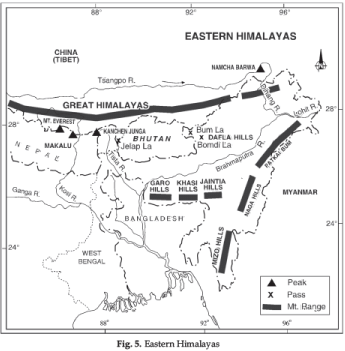
(iii) Ganga Plain. This plain has been formed by the deposition of sediments brought by the Ganga and its tributaries. It can be divided into three regions–upper Ganga plain, middle Ganga plain and the lower Ganga plain. It occupies an area of about 3.5 lakh sq. km. Sunder Ban Delta is formed in the lower Ganga plain. The northern area is called Para-Delta while the southern part is called delta.
(iv) Brahmaputra Plains. These plains are situated in the Eastern part and are often known as Assam valley. The Brahmaputra river forms a large delta in Bangladesh.
3. THE PENINSULAR PLATEAU
The Deccan Plateau is the oldest plateau of India. It is surrounded by oceans on three sides. Therefore it is often called Peninsular plateau. It covers an area of about 16 lakh sq. km. The average altitude of the plateau varies from 600 to 900 metres. Its limits are formed by the Aravallis in the North, West and Delhi-ridge in the north. Rajmahal Hills and Shillong Plateau in the East are its sides. The southernmost point is known as Kanniyakumari. Due to continuous erosion, the plateau shows signs of old age.
Characteristics
(i) It is an ancient, stable, hard block formed by Igneous and Metamorphic rocks.
(ii) It was a part of Gondwana Land which included plateaus of Africa, Arabia and Australia.
(iii) Most of Deccan plateau has been formed by flow of lava and is called Deccan trap.
(iv) It is the store-house of mineral wealth of India.
(v) This plateau has been dissected by river valleys and escarpments.
(vi) It has been divided into several parts by erosional work.
(vii) It is marked by features of Terraced slopes, Faults, residual hills, scarps, rift valleys and a complex of hills.
(viii) The main reason for diversity of relief features are earth movements, Erosional processes, emergence, subsidence Folding and Faulting.
Division of Peninsular Plateau. A series of low hills, known as Satpura ranges, between 21° N to 24° N latitude divided the Peninsular plateau into two parts :
(a) Malwa Plateau
(b) Deccan Plateau.
(a) Malwa Plateau. The Malwa plateau covers a large part of central Highlands. It extends from Aravallis in the West, Ganges valley in the North and East, and Vindhyas in the South. The Aravallis are residual mountains or Relict Mountains extending upto DelhiRidge. Its highest peaks are Mt. Abu (1158 metres) and Guru Shikhar (1722 metres). Thar desert to the west of Aravalli consists of Barchans (Sand dunes). This plateau includes Bundelkhand, and Chambal valley. This Vindhyan plateau consists of long narrow ridges made up of Quartzite rocks. It extends upto Mahadeo Hills, Kaimur range, Maikal range, Rajmahal hills in the East. In the East, lies Chotta Nagpur plateau drained by Damodar river. This plateau is the store-house of minerals of India. The plateau is 1070 metres high.
(b) Deccan Plateau. This plateau lies South of Narmada river. It is surrounded by mountain ranges on three sides–Western Ghats; Eastern Ghats and Satpuras. Narmada and Tapti valleys are rift valleys between Satpuras and Vindhyas. Karnataka Plateau lies between Eastern Ghats and Western Ghats, Malnad and Lowland are the two parts of Karnataka plateau, with Bababoodan Hills. Deccan plateau is a tilted plateau with a general Eastward slope. It covers an area of about 70 lakh sq. km. Its average height varies between 500 metres to 1000 metres. The rivers have divided this plateau into many sub-divisions :
(i) Western Ghats. Western Ghats extend from Tapti valley up to Kanniyakumari for about 1500 kms. It has three passes– Thal ghat, Bhor ghat and Pal ghat. These ranges rise abruptly from the coast. Short swift streams flow towards the west and do not form deltas. The average height is about 1200 metres. Godawari, Krishna and Cauveri rivers rise from western ghats and flow towards East.
(ii) Eastern Ghats. Eastern Ghats extend for about 800 kms. from Mahanadi valleys upto Nilgiris. These are not continuous ranges. Rivers form wide gaps. Javadi, Polkanda Shevroy and Nallamalai hills are found in the Southern part.
(iii) Nilgiris. Western ghats and Eastern ghats join together to form a knot known as Nilgiris. Anamudi (2698 metres) is the highest peak. Anaimalai, Palni and Cardamom Hills are found in the southern part.
These hills are formed by granite and gneiss rocks.
4. COASTAL PLAINS AND ISLANDS
The Peninsular plateau is flanked by narrow coastal plains on the Eastern and Western Margins.
(i) The Eastern Coastal Plain. It extends from Mahanadi Delta upto Kanniyakumari. Its width varies from 50 to 500 km. Mahanadi, Godavari, Krishna, Kaveri form broad deltas on this coast. Sand dunes and lagoons exist on this coast. Chilka lake and Pulicat lake are the two important lagoons. It is also known as Coromondal coast.
(ii) The Western Coastal Plain. This is a narrow coastal plain about 10 to 50 km. wide. It extends between the Arabian Sea and Western Ghats. It has three sub-divisions. Konkan coast from Gulf of Khambhat to Goa, Kanara coast from Goa to Cochin ; Malabar coast from Cochin to Kanniyakumari; lagoons along Malabar Coast join together to form water-ways.
(iii) Islands. Andaman-Nicobar islands lie in Bay of Bengal. There are 572 islands mostly small to be inhabited. These extend from 6°N to 14°N latitudes. These include 214 islands in Andaman and 19 islands in Nicobar. 10° channel separate the two groups. These are the tops of submerged hills in the ocean. Barren island is the only active volcano of India. The islands of Lakshadweep in the Arabian Sea lie 320 km. off the coast. Indira point (Nicobar islands) is the southernmost point. Lakshadweep islands are Coral islands (Atolls).
These include 36 islands from 8° N to 12° N (latitudes).
Q. 3. ‘‘All the major physical features are found in India’’ Do you agree? Explain.
Ans. Yes, we are agree with this statement due to the following reasons :
(i) India’s relief has many contrasts. The relief features in hilly areas and plain are quite different.
(ii) In hilly regions, there is rugged terrain of mountains.
(iii) In plains there are vast stretches of plains or lowland.
(iv) The desert region is covered with sand in the Western Rajasthan.
(v) Plateaus are in southern region of India while two island groups are in Bay of Bengal and Arabian Sea respectively.
In fact, India has major physical features of the earth.
Q. 4. What values make physiographic divisions of India complementary to each other and strengthen the unity of people?
Ans. India is divided into three major physiographic divisions, i.e. the Himalayas, the Northern Plains and the Peninsular Plateau. The peninsula is the core of the geology of India. It is a stable block of hard rocks around which other physiographic divisions have been formed. The plateau is a store house of minerals, which are the base of industralisation of India. The northward drifting of Peninsular Plateau led to the formation of the Himalayas. The Himalayas adorn like a crown. These are the source of forest as well as water wealth and enclose the Indian sub-continent. Sediments brought down from the Himalayas have been deposited to form the Northern Plains. The Gangetic plain is the cradle of Indian civilisation. These are the granaries of the country. The coastal region provides sites for fishing and ports. Thus, these physiographic divisions help to strengthen the forces of unity of people.
|
70 videos|324 docs|53 tests
|
FAQs on Long Question Answers: Geological Structure and Physiography - Geography Class 11 - Humanities/Arts
| 1. What is geological structure? |  |
| 2. What is physiography? |  |
| 3. How are geological structures formed? |  |
| 4. What is the significance of studying geological structures? |  |
| 5. How does physiography impact human activities? |  |
















